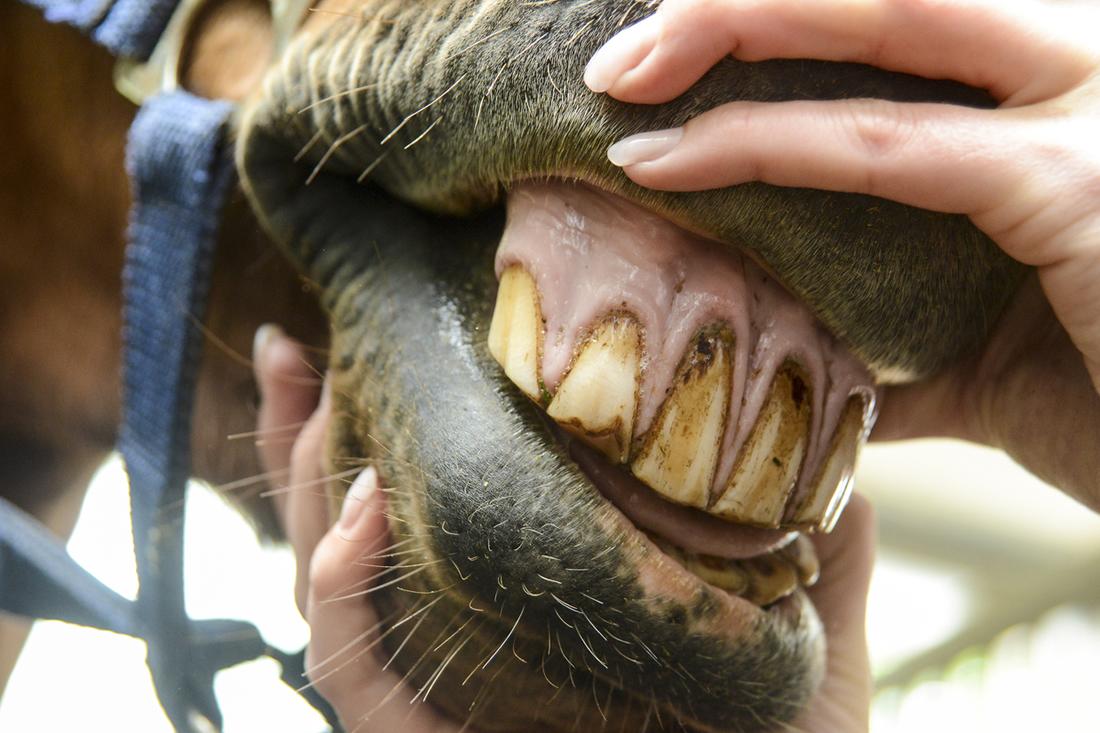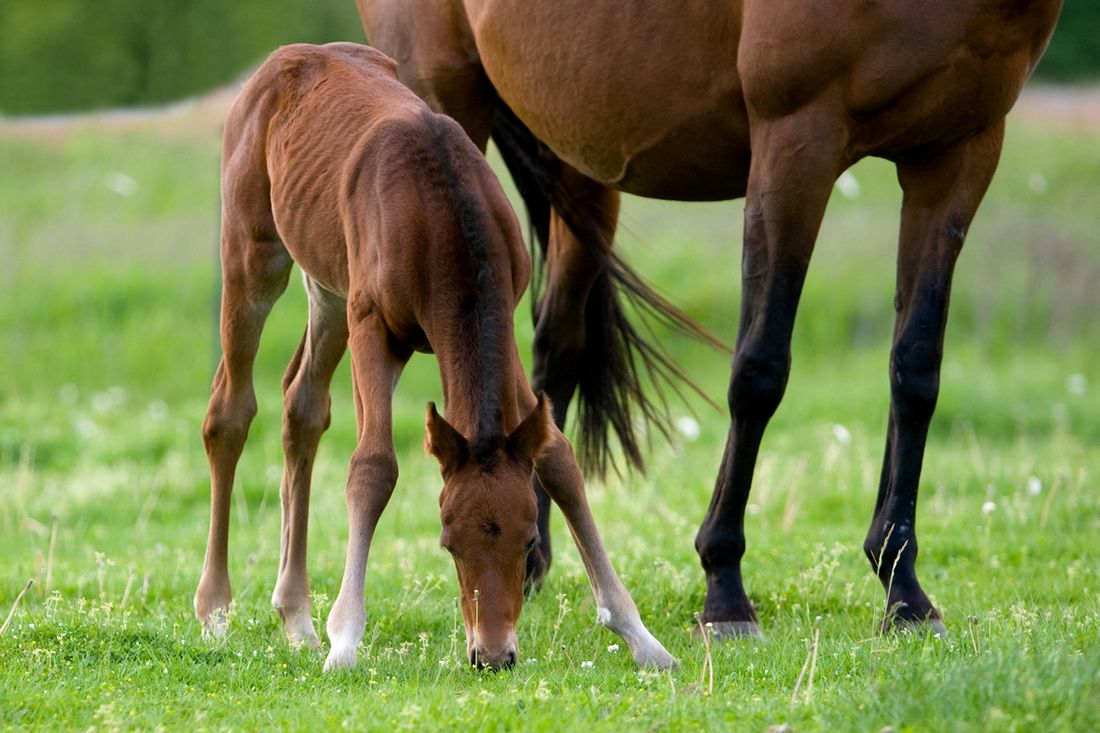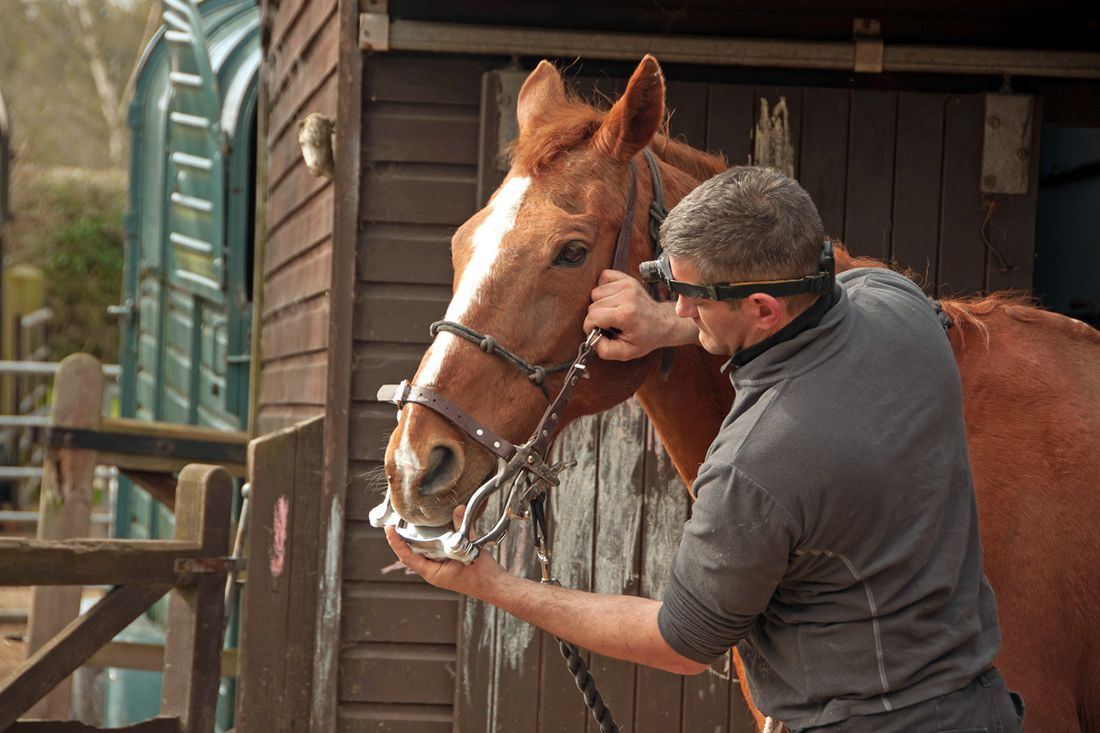The horse is an athletic animal, designed to move in forward motion at high speeds. Repetitive high-strain movements outside of their ordinary range of motion, such as jumping, can make the horse’s back and limbs susceptible to injuries. [1]
A hunter’s bump, or sacroiliac subluxation, is a hump on the horse’s lower back that develops above the croup. It is most apparent when viewing a horse in motion from behind.
Hunter’s bumps are usually caused by the displacement or dislocation of a sacroiliac (SI) joint in the lower back. The condition can affect one or both sides, depending on the horse’s conformation and the severity of the injury.
Signs of a hunter’s bump can be improved with supportive treatment and careful management practices. A combination of stall rest, medication and alternative therapies reduce SI joint pain in the horse and promote healing.
If you think your horse could be developing a hunter’s bump or SI joint pain, contact your veterinarian to obtain a diagnosis.
Hunter’s Bump in Horses
A hunter’s bump can occur when ligaments in the SI joint are torn or strained due to repetitive stress or a traumatic event, such as a pelvic fracture.
This causes a bony prominence of the pelvis (tuber sacrale) to be pushed upwards, creating a bump in the horse’s back.
A hunter’s bump can also occur naturally due to pelvic asymmetry or the horse’s conformation. Horses with naturally long hip bones may have a prominent bump on the rump, which does not hinder performance. [2]
Sacroiliac subluxation is very common in jumping sports, which is where the condition gets the name “hunter’s” or “jumper’s” bump. [3]

Sacroiliac Joints
The sacroiliac (SI) joints are low-motion joints in the horse’s lower back, situated on either side of the spine. These joints link the lower part of the spine to the pelvis, acting as shock absorbers for propulsive forces and supporting the back during motion. [4]
The SI joint is found under 8-11 cm below overlying muscles. This makes it difficult to palpate for diagnosis and to provide effective treatment. [5]
Risk Factors
SI joint injuries are most common in performance breeds, such as Thoroughbreds, Standardbreds and Warmbloods.
Unconditioned and young horses that begin high-level performance training without an appropriate adjustment are likely to develop SI joint pain or discomfort. Sudden, excessive strain on the SI joint during hindlimb flexion can lead to ligament tears and dislocation.
Horses with muscle wasting along the topline or croup are more likely to injure their sacroiliac joints. [3]
Senior horses are more susceptible to joint degeneration, loss of flexibility in the back and loss of muscle strength. They also have slower recovery from injuries, making them susceptible to musculoskeletal abnormalities due to overcompensation. [6]
Overweight horses carry a heavier load, which makes them more likely to strain muscles and joints.
Horses with poor symmetry between pelvic bones may be more susceptible to developing a hunter’s bump and regional pain, but more research is needed.
Clinical Signs
Hunter’s bumps are not inherently painful, although they are often accompanied by back pain.
Mild bumps are referred to as blemishes and not a source of lameness, as they don’t necessarily cause discomfort for the horse or affect performance. [2]
Horses with poor muscle definition in the back and hind end may have a more prominent bump.
Severe Hunter’s Bump
Severe bumps and accompanying sacroiliac or back pain can be identified by the following clinical signs: [4][5]
- A prominent unilateral or bilateral bump above the croup
- Poor performance
- Gait abnormalities (ie. shortened strides, disunited canter, “bunny-hopping”)
- Reluctance to move and jump
- Lack of impulsion
If your horse is displaying signs of back pain or developing a bump above the croup, contact your veterinarian for examination and diagnosis.
Diagnosis
Back pain can be difficult to diagnose in the horse, due to the inaccessibility of the structures of the spine and pelvis. Some structures in the lumbar-sacral region can be palpated to help determine the affected area, but the SI joint is very deep under the skin. [7]
Pain or injuries in the lower hind limb can also transfer up the leg, into the pelvic region. This can cause secondary lumbar sacral injuries that are challenging to diagnose because the primary injury can be overlooked. [8]
SI joint displacement or inflammation rarely presents with typical lameness or pain symptoms, which further complicates diagnosis. SI joint abnormalities can go unnoticed for years. [4]
Examination & Imaging
Diagnosis of hunter’s bump involves a physical exam and diagnostic imaging. Ultrasonography and nuclear scintigraphy can be used to assess ligament injuries in the pelvis, while x-ray is used to visualize the bones.
These images are often difficult to interpret due to significant natural variation in structures and the depth of pelvic structures below muscle.
Currently, a dorsal image of the sacrum is considered the best option for comparing SI joints and making a diagnosis. [6]
Other Causes of Back Pain
If you suspect your horse has hunter’s bump, your veterinarian will perform a full lameness exam to rule out other conditions or injuries.
In a report of 443 horses with back pain, only 15% had chronic SI joint problems. [9] Other common causes of back or pelvic pain include:
- Osteoarthritis
- Pelvic stress fractures
- Ilial wing fractures
- Sacral fractures
- Sarcoiliac sprain
- Aortoiliac thromboembolism
- Exertional rhabdomyolysis (“tying-up“)
- Trochanteric bursitis
- Impinged dorsal spinous processes (“kissing spine“)

Treatment
There are several non-invasive treatments available for SI joint dislocation and hunter’s bumps. With the help of proper saddle fit, training and consistent supportive care, your horse can be made more comfortable and may return to work.
However, a hunter’s bump is almost impossible to reverse completely in mature horses. Young horses with developing tissues respond better to prompt treatment.
Once total ligament separation and dislocation occur, the development of scar tissue prevents the tuber sacrale from falling back into place.
Symptoms and appearance of the bump can diminish overtime, but it is rare for a hunter’s bump to disappear completely.
Stall Rest
The most common treatment for horses with back or pelvic injuries is stall rest. Horses that develop a hunter’s bump should be rested for a few weeks, to limit movement and minimize further strain on the area.
After the initial inflammation or swelling from the injury has subsided, the horse may be able to gradually return to exercise as directed by a veterinarian.
Pain Relief (NSAIDs & Muscle Relaxants)
Non steroidal anti-inflammatory drugs (NSAIDs) are usually given to reduce inflammation and pain after an injury. These medications, such as phenylbutazone (Bute) and flunixin meglumine (Banamine), are cost-effective and easily accessible. [10]
Analgesics (pain medicines) can be injected, administered orally or applied topically to the skin, depending on the medication or brand. Phenylbutazone is generally administered at a dose of 2.2mg/kg every 12 hours, while flunixin meglumine is given at 1.1mg/kg every 12 hours.
Always consult with your veterinarian before giving your horse any medication and ensure you are using the correct dosage. Extended use of NSAIDs for back pain or other conditions can cause ulcers and hindgut dysfunction.
Muscle Relaxants
SI joint injuries can result in protective muscle spasms in the nearby musculature. [6] This is a natural reflex that protects the joint from further injury but can result in muscle stiffness and pain.
Muscle relaxants, such as dantrolene and methocarbamol, may be administered following a traumatic injury to reduce spasms in the area. [11]
Relaxants are a less common treatment, but may be used in conjunction with physical therapies and NSAIDs at the discretion of your veterinarian.
Physiotherapy
Several forms of bodywork and physical therapy have been used to treat hunter’s bump in horses, including acupuncture, laser therapy, ultrasound, massage and chiropractic.
Acupuncture & Laser Therapy
Acupuncture is an ancient Chinese medicine practice that involves inserting needles into the body at specific points to alleviate physical pain and inflammation. This treatment modality is becoming increasingly popular in the horse industry. [1]
Acupuncture sessions take between twenty to sixty minutes and are repeated several times to see improvement for hunter’s bump, back or joint pain.
Laser stimulation of acupuncture points can be used to address lower back pain in horses that are hesitant around needles or sensitive to pain. Laser therapy is easy to perform and has been shown to alleviate lower back pain in horses. [1][12]
Therapeutic Ultrasound
Musculoskeletal pain in horses can be addressed with therapeutic ultrasound (TU). This non-invasive treatment promotes tissue repair in damaged areas by emitting soundwaves that are absorbed by connective tissue. [1]
TU can reduce or eliminate muscle spasms and reduce pain on palpation. [13] Ultrasound waves can penetrate up to 6 cm deep into tissue, reaching non-palpable areas of the back and pelvis, such as the SI joint.
Massage & Chiropractic Therapy
Chiropractic therapy is a non-invasive alternative treatment modality focused on musculoskeletal and nervous system health. An equine chiropractor uses controlled force to adjust and manipulate specific areas of the horse’s body. [4]
Your chiropractor will evaluate the horse’s range of motion and gait, and palpate the joints prior to the treatment. Through manipulation, the pelvis and spinal segments are realigned over several treatments.
Studies evaluating chiropractic treatment on various types of skeletal pain have shown mixed results. Some studies report improvement in symptoms while others report no effect on lameness and/or pain. [14][15][16]
Equine massage therapy is often performed in conjunction with chiropractic therapy. While this treatment is not directly applied to the joints, the mechanical pressure can help loosen tight muscles and improve range of motion in the spine and pelvis. [17]
There is a lack of research on the efficacy of massage therapy in horses, although many owners anecdotally report positive effects in their horses.
Prevention
To promote healthy joints and muscles in the hind end and prevent SI joint strain, horses should be:
- Conditioned gradually
- Ridden with well-fitted equipment
- Trained at their individual fitness level
- Kept at a healthy body weight
- Rested following a bout of exercise
- Kept off of dangerous or slippery surfaces
Saddle Fit
Horses need to be ridden in well-fitting equipment, including a properly fitted saddle and saddle pad. Using ill-fitted equipment can cause muscle problems and back stiffness, as well as hinder performance. [18]
Riding or training in a saddle that does not fit can push the head and neck into a false frame, which causes the horse to hollow the back. This position prevents the back muscles from being supported in motion, putting excess pressure on the spine, sacrum and pelvis. [19]
The spine and sacrum are essentially pushed forwards and down, causing the lumbar vertebrae to form a hunter’s bump to compensate for the dislocation of the sacrum.
Hunting and jumping saddles are often pushed to one side on the back when the horse is in motion and cannot be adjusted to accommodate the horse’s shoulder width. This leads to asymmetries for the horse and rider, resulting in negative pressure on the spine and pelvis.
Professional saddle fitters, trainers, equine physiotherapists and veterinarians work together to help fit a saddle for a horse and its rider. Saddle pads should be clean and lay flat under the saddle without putting unwanted pressure on the back. [8]
Exercise & Training
Although improper exercise programs have not been directly linked to hunter’s bump, they are generally linked to joint injuries in athletic horses. [20]
To prevent injuries to the spine and pelvis, it is important that horses are conditioned for the work they are asked to do. Exercise and training programs should be tailored to the horse’s experience and fitness level, beginning with short and easy sessions.
As the horse becomes more fit and accustomed to training, exercise sessions can become longer and more physically demanding. If a horse has been out of work for an extended period of time, they should be returned to work gradually and not asked to immediately perform at their previous high level.
Riders should be aware of their riding position and balance on the horse to avoid placing unnecessary pressure on the spine and pelvis. If you think your saddle fit, equipment or riding could be affecting your horse’s back, consult with a qualified trainer.
Nutritional Support
In a recent survey of over 2,000 US horse owners, 90% report using dietary supplements to support joint health. [21] However, not all joint health supplements for horses are backed by research.
It’s also important to consider your horse’s diet as a whole and to ensure your horse is getting adequate levels of key vitamins and minerals required for healthy connective tissue.
Horses should be maintained at an appropriate body condition by avoiding excess calories in the diet. Consult with an equine nutritionist to ensure your horse’s diet is appropriately balanced.
In addition to feeding a balanced diet, consider the following research-validated supplements to support joint health: [22][23][24][25]
- MSM (methylsulfonylmethane): a naturally occurring sulfur compound that can support collagen and cartilage production for healthy joints
- DHA (docosahexanoic acid): an omega-3 fatty acid that supports anti-inflammatory processes; only available in marine sources such as algae or fish oil
- Hyaluronic acid: a nonsulfated glycosaminoglycan found in connective tissue
To support your horse’s joint health, we recommend feeding a combination of Mad Barn’s MSM and w-3 Oil, which is a palatable source of microalgae DHA.
References
- Mongkolrat, N. et al. Comparison of High Intensity Laser Stimulation of Acupuncture Points and Therapeutic Ultrasound for
Relief of Chronic Lower Back Pain in Horses. AJTCVM. 2021. - Marks, D. Conformation and Soundness. AAEP Proceedings. 2000.
- Sacroiliac Pain in Horses. Kentucky Equine Research (KER). 2011.
- Haussler, K. K. Chiropractic Evaluation and Management. Vet Clin Equine Pract. 1999.
- Engeli, E. & Haussler, K. K. Review of injection techniques targeting the sacroiliac regiondiagnosedbackproblems. Equine Vet J.2008.
- Haussler, K. K. Diagnosis and Management of Sacroiliac Joint Injuries In book: Diagnosis and Management of Lameness in the Horse. 2003.
- Alvarez, C. B. G. et al. Effect of chiropractic manipulations on the kinematics of back and limbs in horses with clinically diagnosed back problems. Equine Vet J. 2008.
- Protect Your Horse from Back Pain. Kentucky Equine Research (KER). 2012.
- Jeffcott, L.B. Disorders of the thoracolumbar spine of the horse–a survey of 443 cases. Equine Vet J. 1980.
- Jacobs, C. C. et al. Non-steroidal anti-inflammatory drugs in equine orthopaedics. Equine Vet J. 2022.
- Knych, H. K. et al. Pharmacokinetics of methocarbamol and phenylbutazone in exercise Thoroughbred horses. J Vet Pharmacol Ther. 2016.
- Kline, A.M. and Martin, B.B. Jr. Methods of stimulating acupuncture points for treatment of chronic back pain in horses.. J Am Vet Med Assoc. 1989.
- de Melo, U.P. and Ferreira, C. Multimodal therapy for treatment of equine back pain: a report of 15 cases. Braz J Vet Med. 2021.
- Maldonado, M.D. et al. The Effect of Chiropractic Treatment on Limb Lameness and Concurrent Axial Skeleton Pain and Dysfunction in Horses. Animals (Basel). 2022.
- Haussler, K.K. and Erb, H. N. Pressure algometry: objective assessment of back pain and effects of chiropractic treatment. AAEP. 2003.
- Haussler, K.K. et al. Efficacy of spinal manipulation and mobilisation on trunk flexibility and stiffness in horses: a randomised clinical trial. Equine Vet J Suppl. 2010.
- Scott, M. & Swenson, L. A. Evaluating the Benefits of Equine Massage Therapy: A Review of the Evidence and Current Practices.
- Dyson, S.et al. Saddle fitting, recognising an ill-fitting saddle and the consequences of an ill-fitting saddleto horse and rider. Equine Vet Educ. 2015.
- Schleese, J. Kissing Spine & Hunter’s Bump – Poor riding and poor saddle fit can contribute to equine back injuries. Saddlefit 4 Life. 2017.
- Riggs, C.M. Osteochondral injury and joint disease in the athletic horse. Equine Vet Educ. 2006.
- Swirsley, N. et al. Supplement Use and Perceptions: A Study of US Horse Owners. J Equine Vet Sci. 2017.
- Equimed staff. Methylsulfonylmethane. Equimed. 2014.
- Manhart, D.R. et al. Markers of Inflammation in Arthritic Horses Fed Omega-3 Fatty Acids. Prof Anim Sci. 2009.
- Woodward, A.D. et al. Supplementation of dietary long-chain polyunsaturated omega-3 fatty acids high in docosahexaenoic acid (DHA) increases plasma DHA concentration and may increase trot stride lengths in horses. Equine Comp Ex Physiol. 2007.
- Bergin, BJ. et al. Oral hyaluronan gel reduces post-operative tarsocrural effusion in the yearling thoroughbred. Equine Vet J. 2006.














Leave A Comment